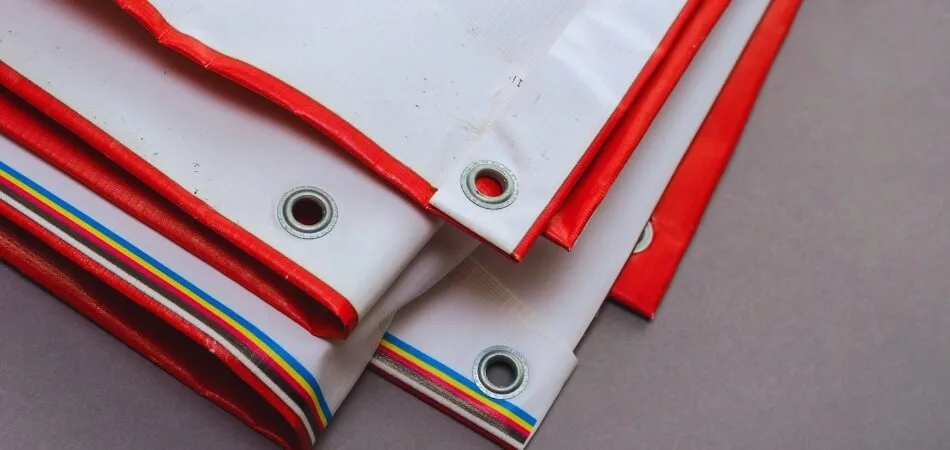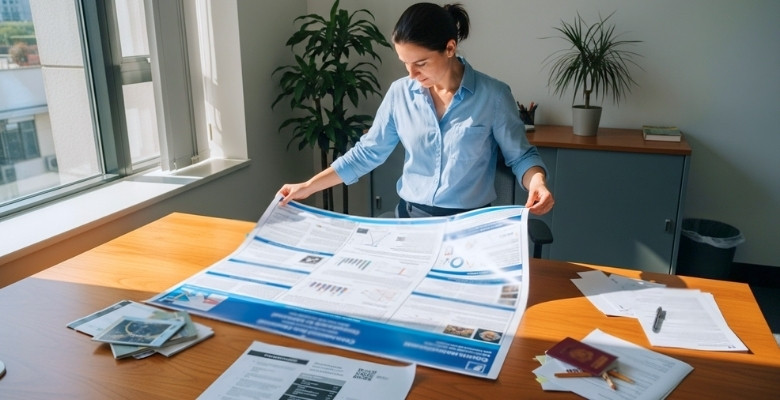A conference poster is more than just printed paper; it carries your ideas and your work in front of people. Many people get worried about carrying it while traveling or packing. You may even find yourself thinking, Can I fold a conference poster?
Yes, you can fold a conference poster if done carefully. Fold gently on a clean surface, align edges evenly, and avoid sharp creases. Protect it inside a sleeve or cardboard, and pack it on top of your bag. These steps keep the poster neat, readable, and safe during travel.
Readers who are curious about keeping their posters neat will find answers here. You will learn about folding steps, risks, common mistakes, and smart alternatives. All the details you need to handle your poster safely are explained in this article.
Can I Fold a Conference Poster?
Carrying a conference poster safely can sometimes feel tricky, especially if you don’t have a poster tube. Folding may be the only option, but it needs care to avoid damage. Let’s look at some simple steps to do it right, especially if you’re wondering how to fold a poster without creasing so it still looks professional when displayed.

Step 1: Clean Hands
Wash your hands well, then dry them fully first. Oils and dirt can stain paper and leave unwanted marks behind. Short nails help avoid scratches while moving across the paper surface. Clean space starts with clean hands before any careful folding work. When you take this first step seriously, the poster remains neat. Small stains or smudges can ruin the design and distract attention quickly.
Step 2: Flat Surface
Clear a wide, flat table or floor area completely. Dust or crumbs will press into paper and create dents easily. Place the poster face up and smooth out wrinkles gently now. Keep drinks away because moisture can ripple and damage prints quickly. A large clear surface also gives space to fold slowly and evenly. Posters folded in cramped areas often get bent, twisted, or unevenly creased.
Step 3: Align Edges
Bring opposite edges together without pressing them yet firmly. Check corners meet evenly, as poor alignment makes deep creases later. Use light taps to nudge edges until everything lines up perfectly. Straight alignment keeps maps, graphs, and text readable after unfolding later. Proper alignment matters when packing posters neatly for upcoming conferences and presentations. A careful fold ensures that the sheet opens flat and looks professional.
Step 4: Gentle Folds
Fold once along the longest side for fewer layers. Press lightly with your palm; never drag fingernails across paper surfaces. If very large, fold into thirds, keeping pressure smooth throughout always. Over-pressing can leave shiny lines that spoil printed colors and details. Smooth folds reduce stress on the paper and keep it flexible. Avoid sharp bends because they are harder to remove once unfolded again.
Step 5: Straight Corners
Watch corners carefully so they never tuck inside accidentally. Misplaced corners create crushed points and long diagonal creases later on. Use a card edge to guide corners flat while folding slowly. Keep checking each corner after folding, then adjust before packing carefully. Corners often catch on bags or sleeves if not folded properly. Straight corners also help the poster fit better inside storage folders.
Step 6: Protective Sleeve
Slide the folded poster into a large envelope gently. If unavailable, place between two folders or clean cardboard sheets instead. This barrier protects against scratches, bending, and unwanted bag friction damage. Label the outside so you can find it quickly later anywhere. A sleeve also makes it easier to stack other items around. Strong covers prevent bending when traveling on buses, trains, or airplanes too.
Step 7: Top Packing
Put the protected poster at the top of the bag always. Heavier items should stay below to prevent crushing and bending pressure. Keep the bag upright and avoid putting tight straps directly over it. When traveling, lift carefully and set down gently to protect everything. Posters packed at the bottom often suffer deep creases and tears. Carrying it at the top ensures it comes out smooth and neat.
Gentle folds reduce damage while keeping the poster neat and readable. Aligned edges stop crooked creases and keep graphics looking sharp later. Place the poster at the top to avoid heavy pressure below. Follow these steps, and your poster will unpack clean and flat, making it the right way to handle situations where you need to know how to fold poster materials safely.
What Decides If I Can Fold a Conference Poster?
What to do with a conference poster often depends on different things. Some posters can be folded, while others may get damaged if handled that way. Knowing what affects this choice helps you avoid mistakes. Let’s go through the main points together.
Poster Material
The type of material used makes a big difference in folding. Paper posters can crease easily, while fabric ones are more flexible. Laminated or glossy posters may crack when folded, losing their smooth look. Choosing the right material matters for safe transport.
Poster Size
Large posters are harder to fold without leaving visible marks. Smaller posters are easier to handle, but they may still crease if the paper is too thin. The size also decides whether rolling or folding is the better choice.
Print Finish
Posters with glossy finishes are more delicate when folded. Matte finishes may handle bending slightly better, but repeated folds still leave marks. High-quality prints can lose their professional look if folded incorrectly. Print finish is important for long-lasting appearance.
Event Policy
Some events do not allow folded posters because they look unprofessional. Many organizers prefer rolled posters that stay smooth and clean. Always check event guidelines before preparing your poster. Following the rules ensures your poster is accepted without any problems.
Transport Options
How you plan to carry the poster also matters in this choice. Rolling a poster in a tube keeps it safe during travel. Folding can make it easier to pack, but it risks damage. Consider convenience and safety when deciding.
A conference poster is more than just paper; it is part of your presentation. Folding may sound simple, but not every poster can handle it safely. Always check the material, finish, and event rules first. Careful handling keeps your poster looking professional.
Common Mistakes and Myths About Folding Posters
Posters are meant to be eye-catching, but their look can be ruined if they are not handled the right way. Many people believe folding them is harmless, but small mistakes can leave lasting damage. Let’s clear up some common myths together.
- Any Fold is Fine: Paper is never meant for deep folds, and even light ones can leave lines. Over time, these lines weaken the paper and spoil the poster’s look.
- Tubes for Folded Posters: Tubes are designed for rolled posters, not folded ones. Forcing folded posters inside a tube only increases creases and damages the corners.
- Creases Vanish Easily: Once a crease forms, it rarely goes away fully. Even pressing or flattening may leave visible marks that reduce the poster’s quality.
- Folding Saves Space: Saving space by folding often costs more in damage. A rolled poster takes little room but stays smooth and presentable.
- Heavy Books Fix Folds: Flattening under books may reduce the fold slightly, but does not erase the damage. Creases remain noticeable under good lighting.
- Shipping Folds Are Safe: Posters folded for shipping may arrive damaged. It is always better to choose rolled shipping for safe delivery.
- Small Folds Don’t Matter: Even tiny folds become bigger over time, especially when the paper is handled often. These marks can spoil the poster permanently.
A poster represents effort, design, and information, so keeping it in good condition matters. Folding might feel easy, but the risks are high. Always roll posters for storage or travel, and treat them with care to keep them looking their best.
Alternatives If You Cannot Carry a Conference Poster
Traveling with a large poster can be tricky and sometimes impossible. Whether it is due to airline rules, luggage limits, or just the hassle of carrying it, you may need other options. Luckily, there are smart alternatives that can help.
On-site Printing
Many conferences offer printing services at the venue itself. You just need to send your poster file in advance or bring it on a drive. This saves travel stress and ensures the poster is ready when you arrive, fresh and damage-free.
Local Printing Shops
Printing near your destination is another safe option. You can search for reliable local shops online before traveling. Sending your file early allows them to prepare it on time. This avoids carrying the poster and reduces the chances of damage.
Ship to Hotel
Sending the poster directly to your hotel is a practical choice. Many hotels accept packages for guests if arranged in advance. This method makes travel easier while ensuring your poster arrives safely and is ready for pickup at check-in.
Modular Boards
Some presenters use posters designed in smaller panels that fit in a bag. These modular pieces can be packed easily and later arranged together on the display board. This creative approach avoids carrying one large sheet while still looking professional.
Backup Digital Copy
Carrying a backup file on a USB or cloud storage is always wise. If traveling with a large poster feels impossible, you can print it locally or even switch to digital display options, so you are still well-prepared for the poster session of conference presentations.
Endnote: Carrying a big poster is not the only way to present at a conference. By planning ahead and using smart alternatives like on-site printing, shipping, or modular designs, you can avoid stress and focus fully on your presentation.
Quick Comparison Table: Paper vs Fabric vs Vinyl
Choosing the right poster material depends on how you plan to use it. Each type has its strengths and weaknesses when it comes to folding, packing, and durability. A quick comparison makes it easier to pick the safest option.
| Aspect | Paper | Fabric | Vinyl |
| Can Fold | Not safe to fold, leaves sharp creases | Safe to fold, folds disappear easily | Can fold lightly, but deep folds cause cracks |
| Best Pack | Rolling in a tube keeps it smooth | Folding into a bag or rolling both work well | Rolling in a wide tube is safest |
| Durability | Tears easily and gets damaged by water | Very strong, washable, and long-lasting | Strong material but sensitive to folding damage |
| Risk | Wrinkles, tears, and loss of a neat look | Small wrinkles that are easy to fix | Cracks, bends, or print damage when folded |
| Fix | Wrinkles cannot be fully repaired | Wrinkles can be removed with ironing or steaming | Some folds can be reduced with heat, but not always perfectly |
| Weight | Lightweight but fragile | Light and flexible, very easy to carry | Heavier than paper or fabric, harder to pack small |
| Best Use | Good for low-cost, short-term posters | Great for travel, reusable, and professional | Works well for glossy, high-quality display posters |
Paper is fine for cheap, quick prints, but is risky for folding. Fabric is the best for travel, easy packing, and reuse. Vinyl looks professional but needs extra care when packing. Choosing the right one depends on your travel and event needs.
FAQs About Can I Fold a Conference Poster?
Finding the best way to carry a conference poster often leads to many small questions. People want to know how to avoid mistakes and keep their posters looking neat. These FAQs clear up common doubts and give simple, practical answers. Let’s explore them together.
Is Folding Different From Rolling?
Folding creates sharp lines that may leave marks, while rolling keeps the surface smooth. Posters rolled into tubes are easier to unpack and display later. Folding is sometimes necessary, but it should be done very carefully. Rolling is always the safer choice whenever possible.
Does Poster Thickness Matter?
Yes, thickness plays an important role in folding safety. Thin paper creases quickly and shows permanent marks when folded. Thicker materials like cardstock or laminated prints resist folds a little better. The sturdier the poster, the harder it is to fold safely.
Can Fabric Posters be Ironed?
Fabric posters are unique because small wrinkles can be fixed with heat. Using a warm iron or steamer on a low setting removes creases easily. Always place a cloth between the iron and the fabric to protect the print. With gentle care, fabric posters look smooth again.
Are Travel Tubes Always Needed?
Travel tubes are very useful, but not the only option. Some people use strong cardboard folders or protective sleeves instead. A tube is best for keeping posters smooth during flights and long trips. If you cannot carry one, use flat, stiff covers instead.
Does Humidity Affect Folding?
Yes, moisture in the air can make folding worse. Humidity weakens paper and makes creases more visible after folding. Vinyl posters may even stick together if folded in damp conditions. Always store your poster in a dry, cool place during travel.
Can I Use Tape to Hold Folds?
Using tape on folds is not recommended because it can tear the surface. When removed, tape often leaves sticky marks that spoil the poster. If you must secure edges, use removable clips or bands outside a protective cover. Tape should never touch the printed surface directly.
Are Small Posters Easier to Fold?
Smaller posters are easier to handle, but folding still carries risk. Even small sheets can crease badly if not aligned properly. For short trips, rolling a small poster in a thin tube is still better. Size reduces handling difficulty, but not folding damage.
Can Wrinkles Be Hidden With Lighting?
Strong creases cannot be hidden with lighting at a conference. Projectors or bright spotlights often make folds more visible on glossy prints. Some minor wrinkles may look less noticeable under dim light. But for professional displays, folds are always risky to rely on hiding.
Conclusion
When it comes to carrying posters, the right choice depends on material, size, finish, and event rules. Rolling is usually safer, but some fabric posters can be folded without trouble. So, if you are asking, can I fold a conference poster? The short answer is yes for flexible fabric posters, but risky for paper or glossy ones.
To keep your poster looking sharp, always check event guidelines, protect it with covers, and plan safe transport ahead of time. Choosing the right material and method saves stress and avoids damage. Handle your poster with care, and best wishes for a smooth presentation.







